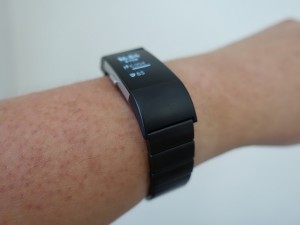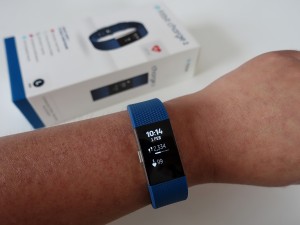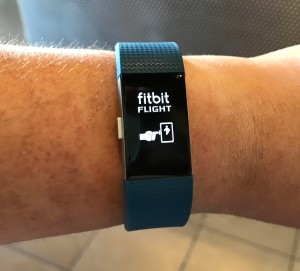Fitbit Charge 2 is a health tracker product from Fitbit capable to count steps, count stairs climbing, track sleep and monitor heart rate. Looking from the design, it is meant to be worn as smartwatch. It has basic display allowing us to see time, step counter, stairs climbed, heart rate, active minutes and even notifications from our phones. I started using this tracker 3 weeks ago. I wear it on my left wrist almost 24 hours a day, tracking everything it can track.
My first impressions on Fitbit Charge 2 was mostly positive. The tracker looks good and it works as expected to perform the features it promises. Design-wise, it looks decent. I am not embarrassed wearing it as a watch, but also not super excited about it. The display is simple and straightforward, easy to read indoor and outdoor, no colour display, no fancy gimmicks, just enough to tell us information what it should deliver.

There are 8 clock faces to choose. Not much, but at least it allows some sort of customisation of what we see. We interact with the tracker using 2 input methods: pressing the only button on the left side, or tapping the screen. Worth to note that the screen is not a touch screen, so the tap here is not the same as the typical tap on most smartphone screens. We need to do somewhat harder tap for it to get detected. Pressing the button will cycle through some menus defined through Fitbit app. Tapping the screen will cycle through different display within the currently-selected menu.
Fitbit Charge 2 comes with removable bands. This is very useful because we won’t need to get a whole new tracker when our band is worn out. As a nice bonus, this also opens whole new possibilities of third party accessories. I got myself a stainless steel band compatible with this tracker and it looks somewhat better, at least in my opinion. The default band is made from elastomer material. Not the most comfortable material to wear 24×7, but also not awfully bad. I didn’t have any discomfort problem during the first week. Then I started to experience occasional discomfort during second week, followed by some skin irritation and itches at the beginning of my third week. I solved the irritation problem by some skin products and prolong the period of not wearing it every evening at home. It helps because it gives my skin more time to breathe normally.
On the area of step counting accuracy, Fitbit Charge 2 inherits most of the issues commonly happen to other trackers that we wear on wrist. It detects more steps when our hand is actively moving and it detects less when we are walking but the hand moves less due to carrying something. I compared the counted steps between Fitbit Charge 2 on my left wrist and Fitbit One on my belt. When I actually walk outdoor, for every 1,000 steps detected by Fitbit One, Fitbit Charge 2 detects roughly 800-900 steps. However, when I’m not actually walking, just being at home doing house chores and a number of other activities, Fitbit Cahrge 2 would register around 100 extra steps within 2-3 hours on a typical evening. The interesting part is, sometimes some of those extra steps got purged when I synced both trackers to my phone. It seems that their algorithm combining results of multiple trackers is more than just matching-and-adding everything.
 There is one new target appearing in my Fitbit app right after I pair the new Charge 2. Now, more than just trying to do x steps every day, Fitbit also encourage us to do at least 250 steps every hour. 250 steps sound simple, but to actually doing it every hour turned out to be more difficult than I initially imagined. Especially when we need to do various desk-jobs during our work hours. I guess that’s also one of its points. People working on modern desk-jobs are often glued to their monitor screen for hours every day and not doing even the bare minimum of physical activities. Making sure to do 250 steps every hour is a nice effort to the right direction.
There is one new target appearing in my Fitbit app right after I pair the new Charge 2. Now, more than just trying to do x steps every day, Fitbit also encourage us to do at least 250 steps every hour. 250 steps sound simple, but to actually doing it every hour turned out to be more difficult than I initially imagined. Especially when we need to do various desk-jobs during our work hours. I guess that’s also one of its points. People working on modern desk-jobs are often glued to their monitor screen for hours every day and not doing even the bare minimum of physical activities. Making sure to do 250 steps every hour is a nice effort to the right direction.
It is a shame that the reminder to move, 10 minutes before the end of every hour, is as good as useless. All it does is a short vibration with a message that appears at that time only. If one is at least in the middle of something that needs focus at work, there’s little chance he/she would have noticed that reminder.
Stairs climbing detection is good and stable. I would say it detects even better than my old Fitbit One, which will strangely refuses to detect any stairs in some particular days. My house has an upper floor, so it’s not possible for me not to climb any stairs in a day.
Sleep tracking is generally good. Unlike my Fitbit One (which requires me to press a button when I am about to sleep and when I wake up), Charge 2 automatically detects our start and end of sleep. From what I noticed so far, the detection is quite accurate. It also auto-detected one nap I did on Sunday. The sleep quality detection is probably another issue. It shows far more restless times compared to my usual experience with Fitbit One. One possible cause is that sometimes I move my hand a lot while sleeping.
Heart rate monitor works reasonably stable. It detects my heart rate most of the time. In about 3 weeks, I experienced 5-10 short periods where I was wearing my Charge 2 on my wrist and yet it did not detect any heart rate number. I had to take off the tracker then re-wore it again for the sensor to resume working. Fitbit help explains that resting bpm is our heart rate when we are awake, calm and comfortable. However, it also mentions that Fitbit uses heart rate data from when we are awake plus when we are asleep to make the estimation. Still a bit of black box here. There were days when I was more agitated (things happened) and the resting bpm did jump high. But there were also days when my resting bpm did not directly correlate to my agitation/stress level.
There is a hidden score called “Cardio Fitness” in the menu of Heart Rate in Fitbit app. I am not entirely sure how it is calculated even after reading the long article that appears when I press that question mark button. My guess is that it is somewhat related to resting bpm in the last several days. To find your Cardio Fitness Score, tab on your Heart Rate to see its graph, then swipe right-to-left on the above area.
Smartphone notification is mediocre at best. It only shows incoming calls, text messages and calendar entries. None of the notifications from third party apps would appear in Fitbit Charge 2. Plus, the notification would only appear once and never again. There’s a very limited use-case on how this could be useful, but for the most parts, it won’t.
Guided breathing is another interesting feature. It basically teaches us how to breathe-to-relax. As simple as this might sounds, perhaps some people do need such guide.
 One extra surprise to find is that there is a hidden game in Fitbit Charge 2. It will only appear after we complete all targets for the day. The game is called Fitbit Flight. It is basically another version of Flabby Bird, a very popular game once upon a time in our smartphones that got pulled by its own creator because of its popularity. It’s a bit of a shame that a company at the level of Fitbit could not come up with original game idea, but the thought to add it as target achievement bonus is something worth of praise.
One extra surprise to find is that there is a hidden game in Fitbit Charge 2. It will only appear after we complete all targets for the day. The game is called Fitbit Flight. It is basically another version of Flabby Bird, a very popular game once upon a time in our smartphones that got pulled by its own creator because of its popularity. It’s a bit of a shame that a company at the level of Fitbit could not come up with original game idea, but the thought to add it as target achievement bonus is something worth of praise.
Hygiene is another issue one should consider when wearing the same accessory for 24 hours a day. Wearing a gadget with form-factor similar to a smart watch will inevitably expose the item to various contamination. Maybe it doesn’t always happen everyday, depending on our activities, but over the long period of time, there bound to be few times it happens. And I am not entirely comfortable with the idea of wearing the same thing when I sleep. One, Fitbit Charge 2’s band is not super easy to clean. Two, even though the tracker itself is water-resistant (but not water-proof), drying the band every time it got some splashes of water is not something I enjoy.
Fitbit promises up to 5 days battery life and I can confirm that it’s actually true and sometimes beyond. I got solid 5 days plus few hours from my first full charge, then 6+ days from my second charge, then another 6+ days from third charge. Maybe I played more with the tracker during my first 5 days, causing the battery to drain a bit faster.
Overall, Fitbit Charge 2 is a good tracker. After initial period, I would probably reconsider about wearing it for sleep tracking, but I will certainly use it during daytime activities. Detaching the band and put it in my pocket while I’m asleep is an idea I will try. This tracker is not a super exciting product, but it’s certainly a keeper.

Leave A Comment